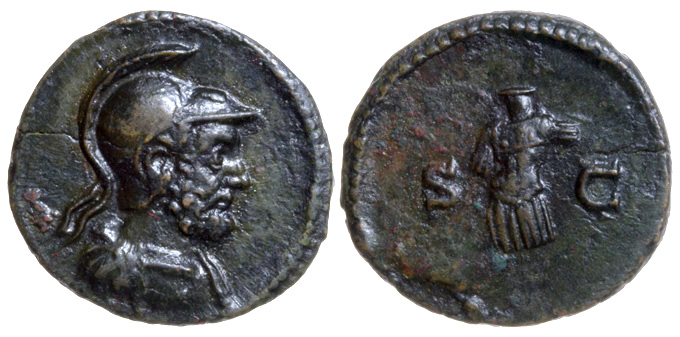 The Quadrans and Semis Denominations
The Quadrans and Semis Denominationsof Roman Imperial Coins
 The Quadrans and Semis Denominations
The Quadrans and Semis Denominations
of Roman Imperial Coins
In the first and second centuries AD the quadrans was the smallest coin denomination used in Rome. It was not worth much then, it was not issued in large numbers, and it was not hoarded (although some were found in jars at bars in Pompeii), so is not common now. The semis was worth two quadrantes (quadrans is singular, quadrantes is plural) and is even less common. Production of both stopped sometime in the middle of the second century, probably because inflation finally made them worth too little.
To the right is an "anonymous" coin, 18 mm in diameter, with a bust of helmeted Mars right/cuirass with S C [RIC II page 218, 19]. It is "anonymous" because omits the name and portrait of the emperor. The anonymous types are attributed to the period from Domitian (81-96) through Antoninus Pius (138-160) or possibly as late as Marcus Aurelius.
The term quadrans is used for small AE coins much more often than semis. They can be hard to tell apart and, if we don't know which it is, we often just call any small coin a quadrans. Scholars think this one is a semis. A smaller version with the same designs is below. Criteria for distinguishing the two denomination are discussed later on this page.
What's new? 2025, Dec. 28: Vespasian/caduceus
2025, July 23: A semis of Domitian/cornucopia. Many images linked to larger images (just click on them).
2024, Sept. 30: A smaller version of the Mars/cuirass type.
2024, April 25: A provincial semis of Trajan.
2023, Sept. 5: anonymous with Griffin/tripod.
Contents. This site first summarizes coins of four categories (photos are to scale):
1) Roman imperial quadrantes attributable to particular emperors from Augustus through Domitian (27 BC - AD 96),
2) Anonymous quadrantes said to be of the period from Domitian to Marcus Aurelius (AD 81-180)
3) Quadrantes from the anonymous time period that can be attributed to a particular emperor, and
4) Coins of the mines--coins the size of quadrantes that mention particular mines.
After the summaries there are
5) Discussion of value and collections.
6) This page also simultaneously discusses coins of the semis denomination, which are often called quadrantes for convenience because they can be hard to tell apart: "Quadrans or semis?"
7) Many other examples organized by emperor.
8) A comment on Roman Republican quadrantes.
9) A a page of reference works about the quadrans denomination.
There is also a page on the frequency of low denominations.
History. The quadrans denomination began under the Roman Republic, but this site is devoted to imperial coins and with only a few comments on Republican quadrantes. We pick up the story when Augustus (27 BC - AD 14) reformed the coinage system to add to it new small denominations. The new system lasted for almost two hundred years. It included the gold aureus, the silver denarius (that had dominated the Republican system), and these smaller copper denominations which had not been issued, or hardly issued in the previous century under the Republic (Almost no bronze had been issued since 86 BC), including the
sestertius four to a silver denarius
dupondius two to a sestertius, eight to a denarius
as (the most commonly found low denomination on archaeological sites) four to a sestertius, 16 to a denarius
semis (The semis was introduced by Nero) two to the as, 32 to the denarius
quadrans four to an as, 64 to a denarius
The quadrans (Greek κοδράντης) is mentioned twice in the Bible (as noted by "Roman Collector" on CoinTalk). The two verses are:
Mark 12:42
καὶ ἐλθοῦσα μία χήρα πτωχὴ ἔβαλεν λεπτὰ δύο, ὅ ἐστιν κοδράντης.
"And one poor widow came and threw two leptons, which is a quadrans."
Matthew 5:26
ἀμὴν λέγω σοι, οὐ μὴ ἐξέλθῃς ἐκεῖθεν ἕως ἂν ἀποδῷς τὸν ἔσχατον κοδράντην.
"Truly I tell you, you will not come out from there until you have paid back the last quadrans."
The lessons depend on that fact that the quadrans is the smallest Roman coin denomination.
Examples from each category are illustrated next. They are followed by comments on their value, collections, distinguishing the quadrans from the semis, many additional examples, and reference works.
1) Quadrantes attributable to an emperor from Augustus through Domitian.
Early imperial quadrantes do not have a portrait of the emperor. Some do not even name the emperor.
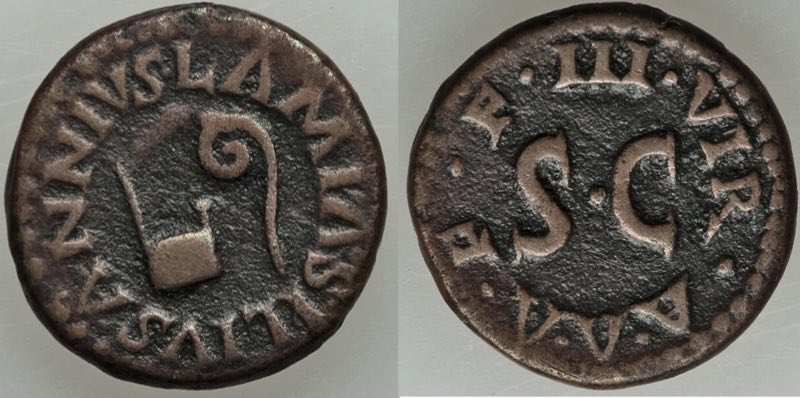 A quadrans struck under Augustus in 9 BC.
A quadrans struck under Augustus in 9 BC.
17 mm.
The coin does not mention Augustus, but does name three moneyers:
LAMIVS SILIVS ANNIVS, around simpulum and lituus
with the reverse naming their office:
III • VIR • A•A•A • F • F
(Triumvir Auro, Argento, Aere, Flando, Feriundo. "Three men for gold, silver, and bronze, casting and striking").
RIC I 421 page 74.
RIC volume 1 is the essential reference for quadrantes of the Julio-Claudian period.
After Augustus, early imperial quadrantes name the emperor. Here is one issued by Claudius (AD 41-54). Claudius is famous from the book and TV series "I, Claudius."
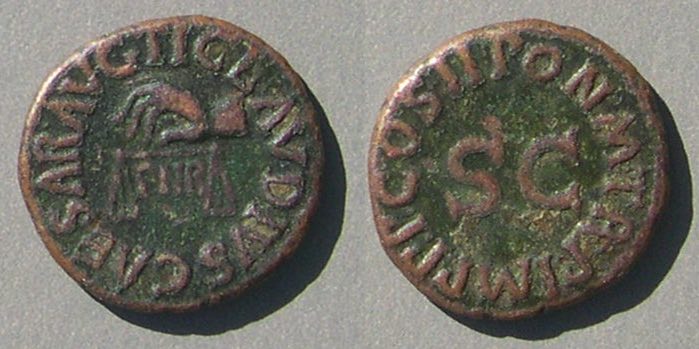 Claudius 41-54, struck AD 42. Quadrans.
Claudius 41-54, struck AD 42. Quadrans.
17 mm. 2.91 grams.
TI CLAVDIVS CAESAR AVG
Hand holding balance, PNR beneath
PON M TRP IMP PP COS II
RIC 91
PNR might abbreviate "PONDVS NVMMI RESTITVTVM" (weight of the [gold] coins restored) which refers to restoring the weight of the gold coins to the higher standard used before Caligula reduced it.
Domitian, 81-96.
17 mm. 3.27 grams.
Rhinoceros left (with two horns) [weak on this example]
IMP DOMIT AVG GERM around S C
RIC II.I 250
Struck 83-85 [Buttrey]
"Domitian was to display a rhinoceros at Rome for the first time in the early 90's." [Birley] This is not right, because the coin must be dated to 83-85 [Buttrey]
The rhinoceros was mentioned by Martial in reference to games of Domitian. Normally placid, it could be extremely violent if provoked.
For more quadrantes that name a particular emperor see below.
There are quadrantes with no indication of who issued them (such as the first coin on this page, and this next one) which are called "anonymous."
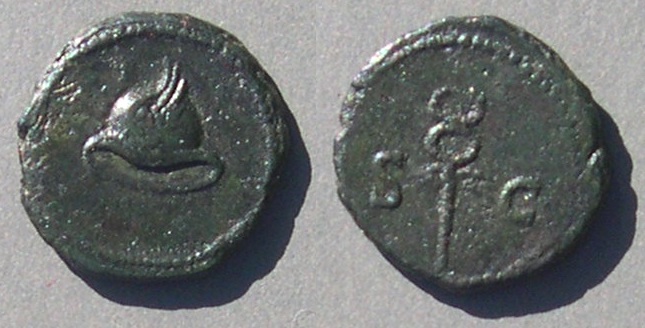 An "anonymous" quadrans
An "anonymous" quadrans
15 mm.
Attributed to the period from Hadrian to Antonius Pius (117-161).
winged petasus (cap of Mercury)
winged caduceus, S C on either side.
Nothing on the coin suggests a particular emperor.
However, there is, below, a quadrans of Nerva with the same reverse.
Perhaps that is enough to infer this coin is likely of Nerva (96-98).
Although when RIC was published the period of anonymous quadrantes was thought to begin with Domitian, Lamb argues that they are later and the great majority are from Hadrian and Antoninus Pius (AD 117 and later).
3) Quadrantes from the anonymous period (i.e. Domitian and later) that name a particular emperor
Some quadrantes from this time period are not anonymous. This one has the name and portrait of the emperor.
16 mm. 2.74 grams.
Trajan, 98-117
IMP CAES NERVA TRAIANVS AVG
laureate head of Trajan right
she-wolf standing right, no legend, SC in exergue
RIC 691, BMC 1060 "undated"
Quadrantes before Trajan do not have portraits of the emperor. This might be a "small semis" [Woytek]
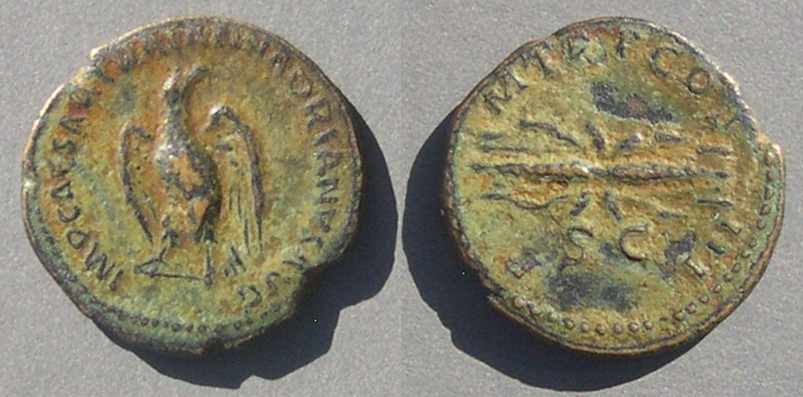 19 mm. 3.26 grams. Semis.
19 mm. 3.26 grams. Semis.
eagle front, head right
thunderbolt above SC
Fortunately the legend
IMP CAESAR TRAIAN HADRIANVS AVG
names the emperor Hadrian (117-138)
and the reverse
PM TRP COS III
narrows the date range to 119-125
RIC 624. BMC 1278. Sear 3704
For more quadrantes identifiable by emperor, see below.
There are rare quandrans-sized coins that name particular mines. Some some name the emperor explicitly, some do not name the emperor but give hints as to who was emperor, and some do not identify the emperor.
Sometimes the type names the emperor.
Coin of the mines. 18 mm.
DARDANICI, woman standing left holding ears of grain
The obverse could be found on a high-denomination coin:
IMP CAES NERVA TRAIAN AVG GERM
laureate head of Trajan right
RIC 703 "R2" "possibly a semis"
BMC 1106
"Trajan's DARDANICI coins belong to the silver mines of Kopaonik and Pristina in Serbia and old Serbia" [BMC note page cix].
Coin of the mines
17 mm.
Head right. It closely resembles Antoninus Pius.
METAL AVRELIANVS in wreath.
RIC III, page 313, 1255 "uncertain" [ruler] but "R2" under Marcus Aurelius.
The name of the mine suggests Marcus. He could be honoring his adoptive father with the portrait.
BMC III --, but BMC IV page 687 has it not in the BM, but cited from a sale.
Coin of the mines
18 mm.
Mars head right in high-crested helmet
METAL DEVM around a cuirass
The style suggests it is from the second century, but the type does not strongly suggest a particular emperor, although Trajan did issue dupondii and asses with a cuirass like this as their reverse type. (RIC 582-3, BMC plate 35.1).
Note for collectors: Coins of the mines are all rare and seldom offered, although Lamb says there are many more available than commonly thought (If so, I don't know where they are.) Not a lot is known about them. They are much more expensive than regular quadrans pieces.
5) Other "Quadrans" Coins.
The quadrans was an "Roman imperial" denomination, as opposed to a "Roman provincial" denomination. However, some provincial coins have the size of an imperial quadrans. Here is one.
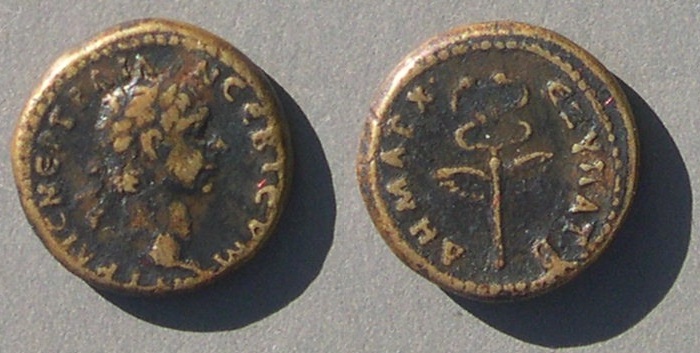 15 mm.
15 mm.
Trajan (98-117), struck at Antioch ad Orontes in Syria
TRAIC NEP TPAIAN CEB ΓEPM
Head of Trajan right
ΔHMAPX EΞYΠATB
(= TRIP POT COS II)
winged caduceus
Mc Alee 502 "Struck 98-99" "Very rare" [I have seen quite a few. I would not call it rare].
RPC III 3657 "Orichalcum struck in Rome for circulation in Syria"
The legend is in Greek (and the coin has a portrait), so it is not an imperial quadrans. Nevertheless, it is somtimes called a quadrans because it probably had that value and we don't know the actual name of the provincial denomination.
Value. What could the quadrans buy? Other than the two verses from the New Testament above, few ancient sources mention the quadrans or semis. Horace says the quadrans and the semis were used for admission to the baths. At one site in Pompei, a tavern had a pot which contained 374 asses or dupondii and 1237 quadrantes [van Heesch, "Coin Supply" p. 133], so it served as small change at a tavern.
Lamb [p. 52] says "during the years of greatest production under the Julio-Claudian dynasty ... Quadrantes played a significant role in the urban economies of Rome and central Italy," and "The purpose of the Anonymous Quadrantes was to provide the bulk of circulating fractional coinage in Rome and the surrounding area during the reigns of Hadrian, Antoninus, and possibly the early years of Marcus Aurelius." This is spite of the fact that "Roman fractions, even in their most abundant periods and urban settings, are never the commonest finds on archaeological sites. ... Copper asses seem to be found four times more often."
Collections. James Lamb, formerly president of Spink's America, wrote an article about quadrantes and his attempt to collect them. I highly recommend it. He found the whole subject more complex than he expected. He notes van Heesch illustrated 591 examples. van Heesch's thesis (in Dutch) is available on-line (see the reference page) and his plates illustrate many types with 3 to 6 examples each, sometimes with different sizes. This web page does not reproduce his work and does not list many of the types. It merely gives an overview. Several sale catalogs have had collections of about 40 pieces (see the reference page).
As I write this, vcoins has 255 imperial examples under "quadrans," very few of which are in high grade, among over 200,000 coins offered. As you can imagine, small denomination coins were useful, but their value was low so they were not worth hoarding, so the ones found today circulated a lot and are usually very worn.
As I write, a search of vcoins on "mines" found no coins of the mines.
Collectors of quadrantes often collect the semis denomination too--both are fractions. Also, only under Nero, who introduced the denomination, do semis coins make up as much as 1/5 the fractional coins--it does not add much to a collection to also include semis pieces. Both denominations are small and they can be hard to distinguish. For example, it would be hard to distinguish the next coin from a quadrans by size alone. (It is only 16 mm and some quadrans pieces are 18 mm.) Scholars decided this coin (illustrated to scale) must be a semis because of the small "S" at the top left of the table.
Nero, 54-68. RIC says struck "up to the course of 66."
16 mm and thicker than his quadrantes. 3.57 grams.
NERO CAESA-R AVG IMP
Head of Nero right, laureate
CER QVI-N-Q ROM-CO
CER(tamina) QVINQ(uennalia) ROM(ae) CON(stituta)
"After the Greek fashion, a triple entertainment, consisting of music, gymnastics, and equestrianism" Stevenson, DRC.
Table, seen from front right, with urn and wreath on top, front panel with two griffins confronted, globe on floor below, and SC in exergue.
RIC 234
Also, the portrait suggests it is a semis. If the current scholarly classification scheme is correct, quadrans coins until Trajan do not have portraits. This type and its connection to games was discussed at length on CoinTalk: https://www.cointalk.com/threads/the-olympics-at-rome.389195/
Quadrans or Semis? It is often difficult to identify the denomination of these small coins. Many dealers don't even bother and sometimes scholars are not certain. If you want simple guidelines, there are two:
1) If it is both small and without an imperial portrait, it is a quadrans.
2) If it is both relatively large and has an imperial portrait, it is a semis.
But there are many types that don't fit in either category and are not easy to classify for reasons discussed next.
Some small coins are orichalcum (brass, which is yellowish when not patinated) which was more valuable than copper in the ratio of 8 to 5, and some are copper. van Heesch identified both quadrantes and semisses in both metals, so the metal alone does not distinguish the denomination. Also, patina often makes it impossible to tell the metal of an AE coin. Some types, regularly identified as quadrantes, are larger in diameter than others identified as semisses. For example, the quadrans of Claudius above is 17 mm and the semis of Nero (just above) is 16 mm. The yellowish color of the Nero coin indicates it is of orichalcum, which makes it intrinsically more valuable than a copper coin of that size would be. However, if it did not have that tiny "S" above the table the argument about its denomination would still be raging. A problem in distinguishing denominations is that the same type may come in various sizes, which suggests the type alone is not enough to tell. For example, the Mars/body armor type at the top which is commonly 18 mm is also found on coins from 14-12 mm. The small ones must be quadrantes and the larger ones semisses.
Portrait pieces are almost always semisses (with exceptions for coins minted for circulation in Syria). Quadrantes before Trajan do not have a portrait of the emperor. The wolf type of Trajan (above) is almost always called a quadrans but Woytek (in his book on coins of Trajan) calls it a "small semis". If a small AE coin is not a portrait piece, it might be a semis anyway. For example, consider the eagle/thunderbolt coin of Hadrian above. The patina makes it hard to tell the metal, but it is 19 mm (the size of a semis) and yellowish so is probably an orichalcum semis (even lacking a portrait). On the other hand, the second next coin (of Claudius) is clearly of copper, not orichalcum, and certainly a quadrans. Scholars have decided that the semis was introduced by Nero, so any earlier small coin is a quadrans.
Caligula (37-41) and Claudius (41-54). They issued well-known types that can be found in pleasing condition.
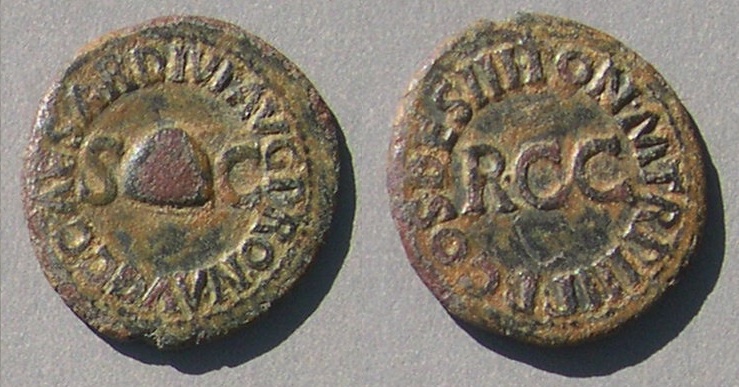 Caligula, 37-41. Quadrans.
Caligula, 37-41. Quadrans.
Cap of liberty between S and C
C CAESAR DIVI AVG P ROIVA xxx
RCC with legend around:
PON M TRP IIII PP COS DES IIII xxx
The meaning of RCC may not be obvious to us, but scholars have decided it means
"Remissa ducentesima", that is "relief from the tax of one part in two hundred"
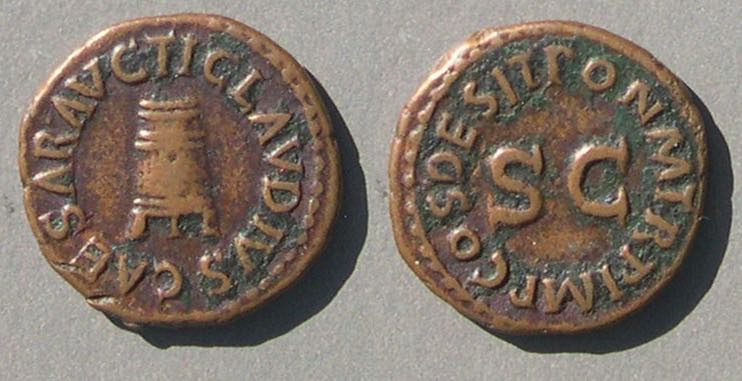 Claudius, 41 - 54. Quadrans.
Claudius, 41 - 54. Quadrans.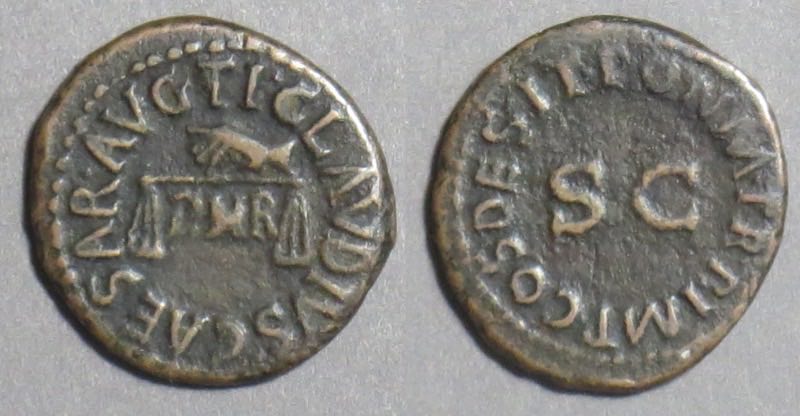 Claudius, 41-54. Quadrans.
Claudius, 41-54. Quadrans.
18 mm. 3.35 grms.
[Another example similar to, but with a different date, than the one with the same design above (third on this page).]
TI CLAVDIVS CAESAR AVG around hand holding balance, PNR between pans.
PON M TRP IMP COS DES IT around SC
RIC 85, page 126. Plate 16.85. "25 January 41 - 3 Dec. 41"
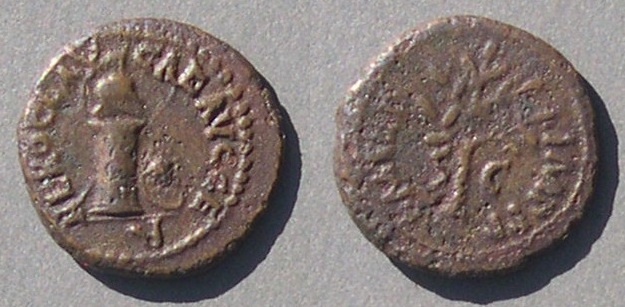 Nero, 54-68. Quadrans.
Nero, 54-68. Quadrans.
15 mm. 2.24 grams.
NERO CLAV CAE AVG GER
Helmet right, on column. Round shield leans on it, spear transverse to right behind.
PM TRP IMP PP
upright olive branch, S C on either side.
RIC 255, struck c. 64.
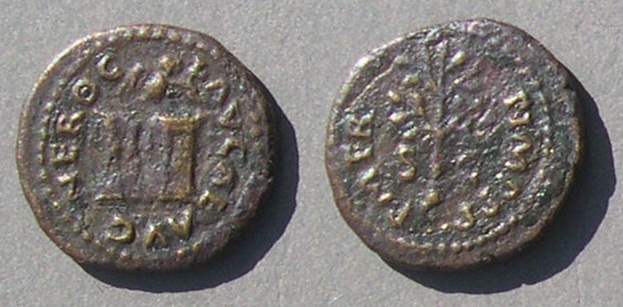 Nero, 54-68. Quadrans.
Nero, 54-68. Quadrans.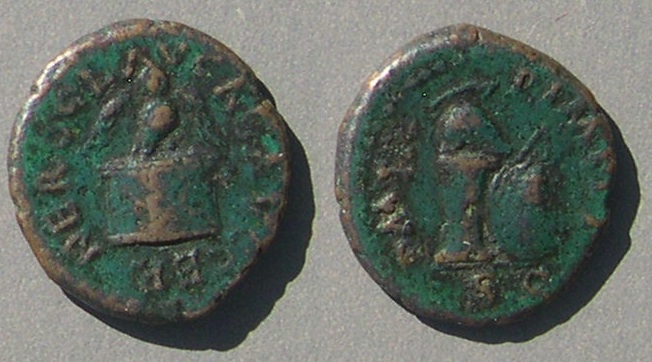 Nero, 54-68.
Nero, 54-68.[Repeated from above. Skip the description if you remember it.]
Nero, 54-68. RIC says struck "up to the course of 66."
16 mm and thicker than his quadrantes.
NERO CAESA-R AVG IMP
Head of Nero right, laureate
CER QVI-N-Q ROM-CO
CER(tamina) QVINQ(uennalia) ROM(ae) CON(stituta)
"After the Greek fashion, a triple entertainment, consisting of music, gymnastics, and equestrianism" Stevenson, DRC.
Table, seen from front right, with urn and wreath on top, front panel with two griffins confronted, globe on floor below, and SC in exergue.
RIC 234
Also, the portrait suggests it is a semis. If the current scholarly classification scheme is correct, quadrans coins until Trajan do not have portraits.
Vespasian and Titus issued only a few quadrans pieces, most with low-quality strikes. Lamb [page 45] says "production seems to be at no more than 10-15% of the volume maintained by the Julio-Claudians."
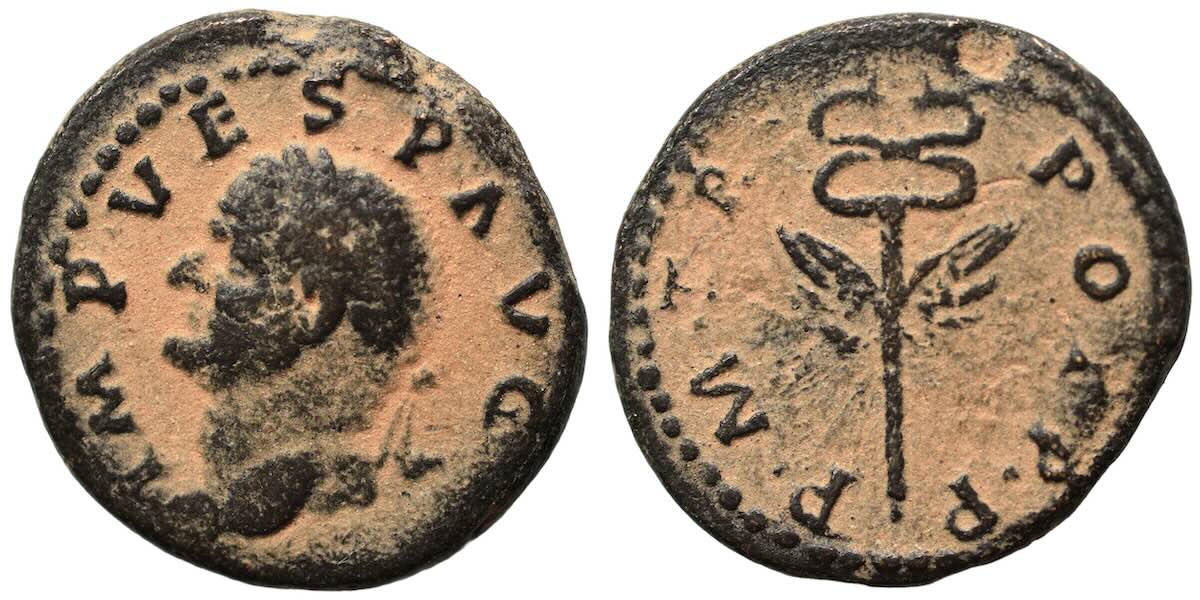 Vespasian
Vespasian
16-15 mm. 2.46 grams.
IMP VESP AVG
Winged caduceus
PM TRPOT PP
Strck 74 in Rome "orichalcum coins minted in Rome predominately for Syria"
RIC II.1 Vespasian 1569, page 179.
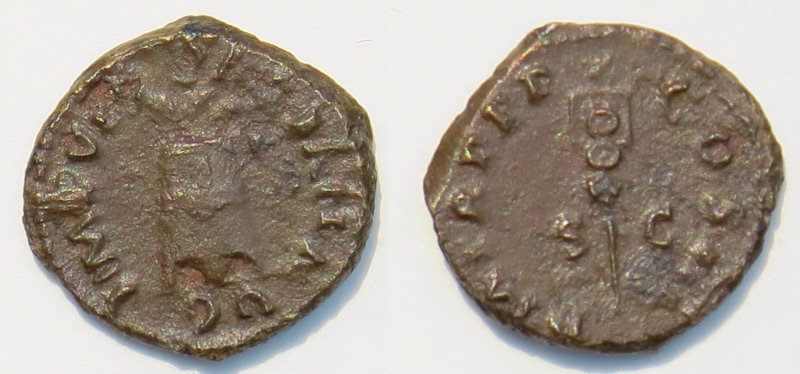 Vespasian, 68-79
Vespasian, 68-79
IMP VESP xxxx
Modius
PM TRP PP COS III
Standard between S and C.
This is a plate coin in Lamb's article, #13, which he remarks is "cold struck."
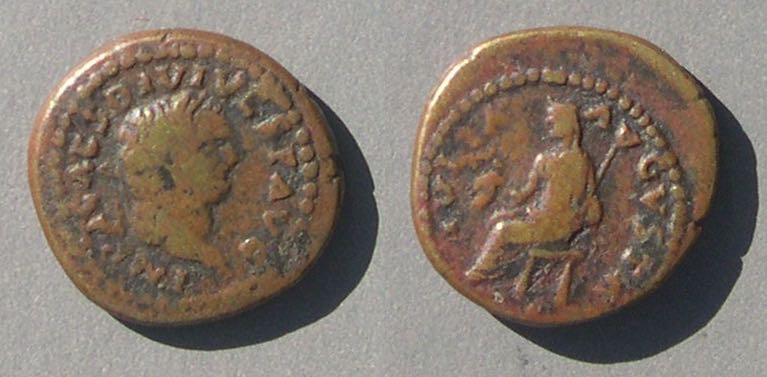 17 mm. 3.89 grams.
17 mm. 3.89 grams.
Domitian issued quite a number of quadrans types with his name, but not his portrait. He greatly increased the supply of small change by minting and sending to the legions in the north much more small change than previous emperors [van Heesch, p.130]. These are undated, but the title "GERM" puts them at or after the resumption of AE coinage in AD 84. RIC puts most in AD 85.
Domitian, 81-96.
18 mm. 4.40 grams.
IMP DOM-IT AVG GERM
Helmeted head of Minerva right.
Olive branch between S C in lower field.
RIC 428, page 207, plate 140 "AD 85".
BMC 81.11, page 410.
Sear 2827.
Domitian, 81-96.
18 mm. 3.27 grams.
IMP DOMIT AVG GERM
Helmeted head of Minerva right
Large S C in laurel wreath
RIC II.I 235, page 282, plate 140 "84-85"
BMC 484
Sear 2824
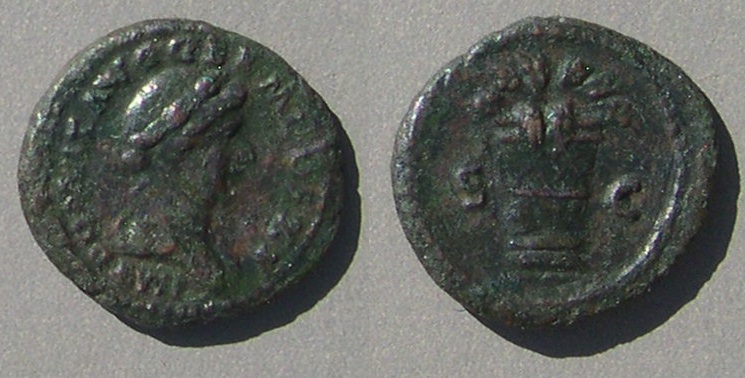 Domitian, 81-96.
Domitian, 81-96.
19-17 mm. 30.5 grams.
IMP DOMIT AVG GERM COS XI (AD 85)
Ceres bust right, wreathed with grain
Modius and grain ears, S C
RIC II.I 315, page 286, plate 143, struck "85".
BMC 321, page 368
Sear 2828 bust right variety
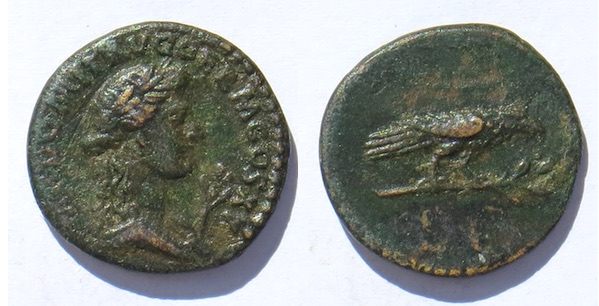 Domitian, 81-96.
Domitian, 81-96.
18 mm. 3.03 grams. Semis.
IMP DOMIT AVG GERM COS XV (AD 90-91)
Apollo head, laureate right, branch before
Raven standing right on branch, SC below
RIC II.I 710, page 316, plate 155 [The RIC plates coin gives Ceres features like Domitian] Struck "90-91".
BMC 453
Sear 2822
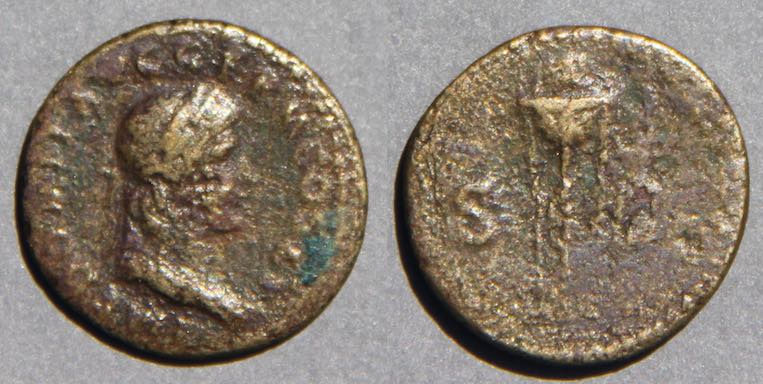 Domitian.
Domitian.
[Repeated from above]
Domitian, 81-96
17 mm.
Rhinoceros left (with two horns)
IMP DOMIT AVG GERM around S C
RIC II.I 250, struck "84-85"
Struck 83-85 [Buttrey]
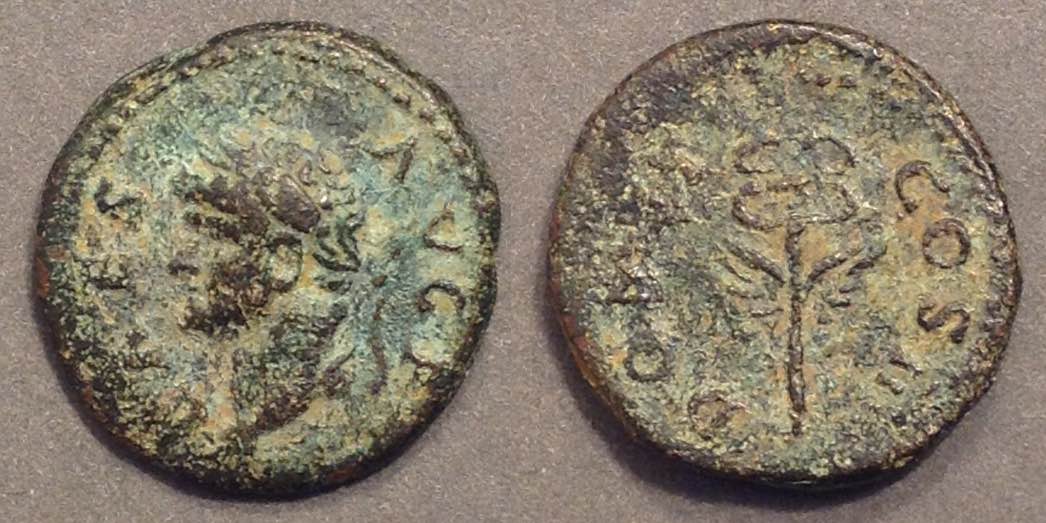 Domitian as Caesar, struck under Vespasian, 74
Domitian as Caesar, struck under Vespasian, 74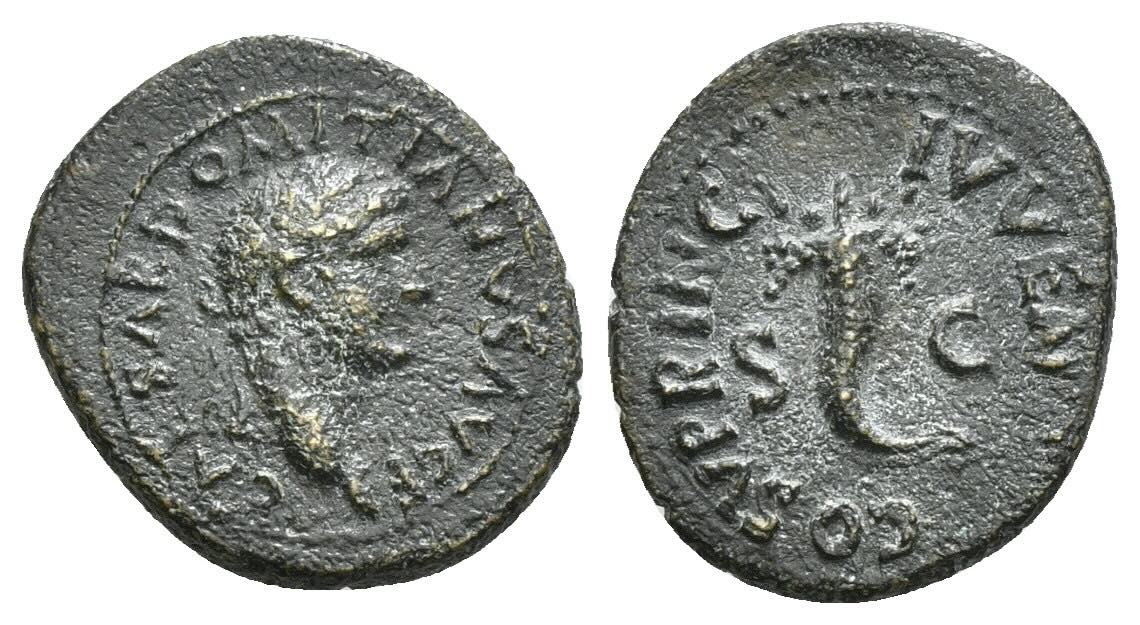 Domitian as Caesar under Vespasian, 77-78.
Domitian as Caesar under Vespasian, 77-78.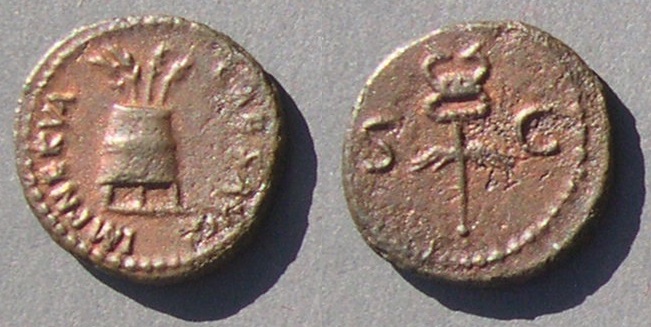 Nerva, 96-98.
Nerva, 96-98.
16 mm. 2.53 grams.
IMP NERVA CAES AVG
modius with four ears of grain
winged caduceus, S C
RIC II Nerva 113 "undated"
Sear 3066
BMC 148
The reverse resembles the reverse on the unattributed "anonymous" coin above, which suggests that coin might also be of Nerva.
Trajan issued quadrantes with and without his portrait. There are several varieties with a wolf on the reverse with no legend other than SC.
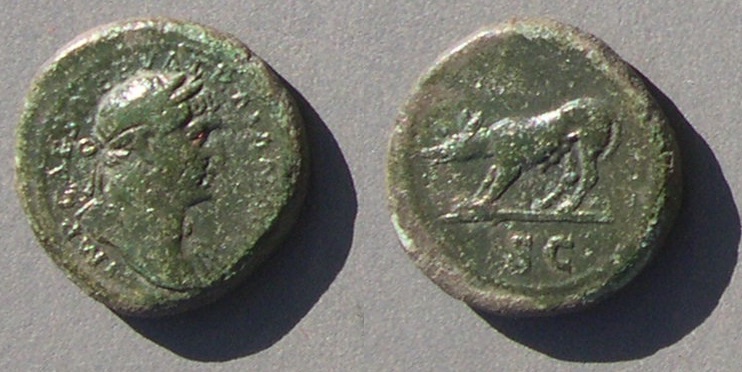
Trajan, 98-117
17 mm. 3.91 grams.
IMP CAES NERVA TRAIAN AVG
Head right, laureate
wolf standing left, SC in exergue
RIC 694 page 293
BMC 1061, page 226 "undated"
Sear 3246 "AD 107"
 Trajan, 98-117
Trajan, 98-117
15 mm. 2.67 grams.
IMP CAES TRAIAN AVG GERM
Hercules head right, bearded
wolf standing left, SC in exergue
RIC 792 has this obverse with a boar walking right
BMC 1063/1060 variety left
Sear II --, obverse of 3248
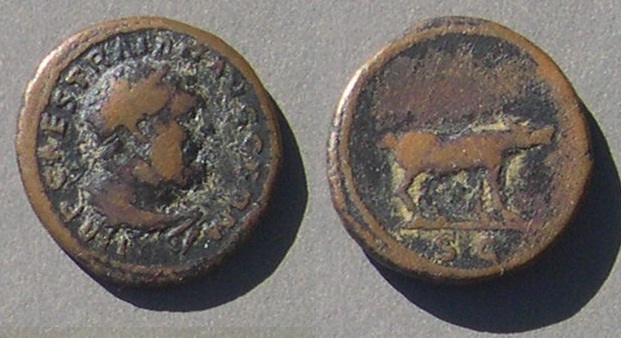 Trajan, 98-117
Trajan, 98-117
16 mm.
IMP CAES TRAIAN AVG GERM
Hercules head right, bearded
boar standing right, S C in exergue
RIC II 702, page 294. Illustration of 691, but described there as a wolf.
It can be hard to tell if a wolf or a boar was intended.
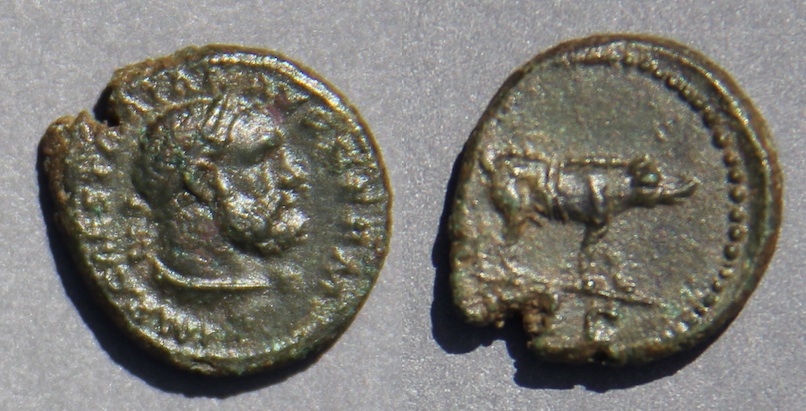 [another example]
[another example]
Trajan, 98-117
15 mm. 2.78 grams.
IMP CAES TRAIAN AVG GERM
Hercules head right, bearded
boar standing right, S C in exergue
RIC II 702, page 294. Illustation of 691, but described there as a wolf.
It can be hard to tell if a wolf or a boar was intended.
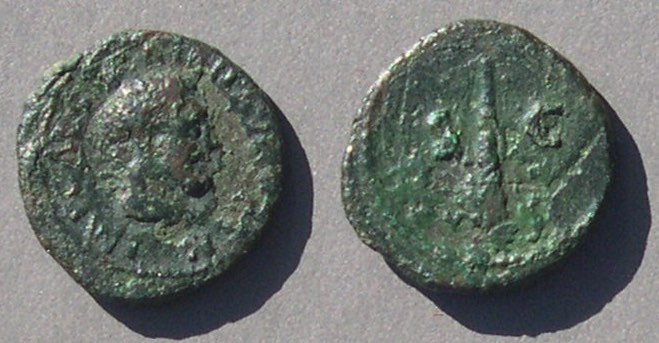
Trajan, 98-117
15 mm. 2.20 grams.
IMP CAES TRAIAN AVG GERM
Head of Hercules right/his club between SC
Fortunately the obverse legend names Trajan.
RIC II 699, page 293, plate XII, 212.
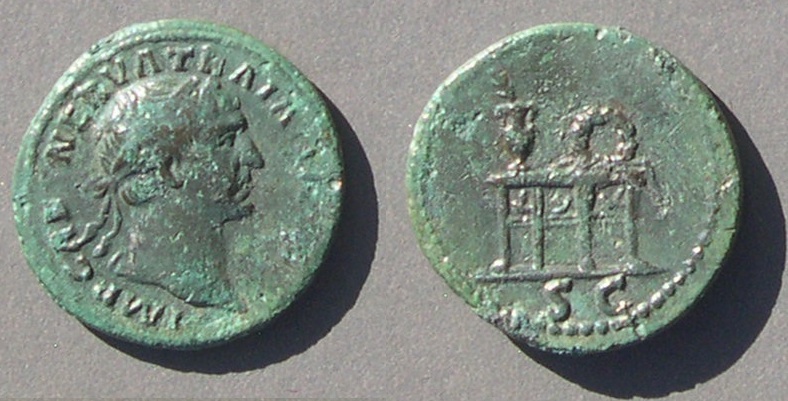 Trajan, 98-117
Trajan, 98-117 Trajan
Trajan
19 mm. 2.93 grams. Orichalcum semis. Antioch mint.
IMP CAES NER TRAIANO OPTIMO AVG GER
Radiate bust right, drapery on far shoulder
S C in wreath,
DAC PARTHICO PM TR POT XX COS VI PP [mostly illegible here, but see the next coin]
RIC 645, page 290, plate 12.209 (reverse only)
BMC 1103, page 233, plate 45.8. Metcalf ANSMN 22 (1977) plate 8.1.
McAlee Antioch 516.
Both the yellow color of orichalcum and the radiate crown indicate this is a semis.
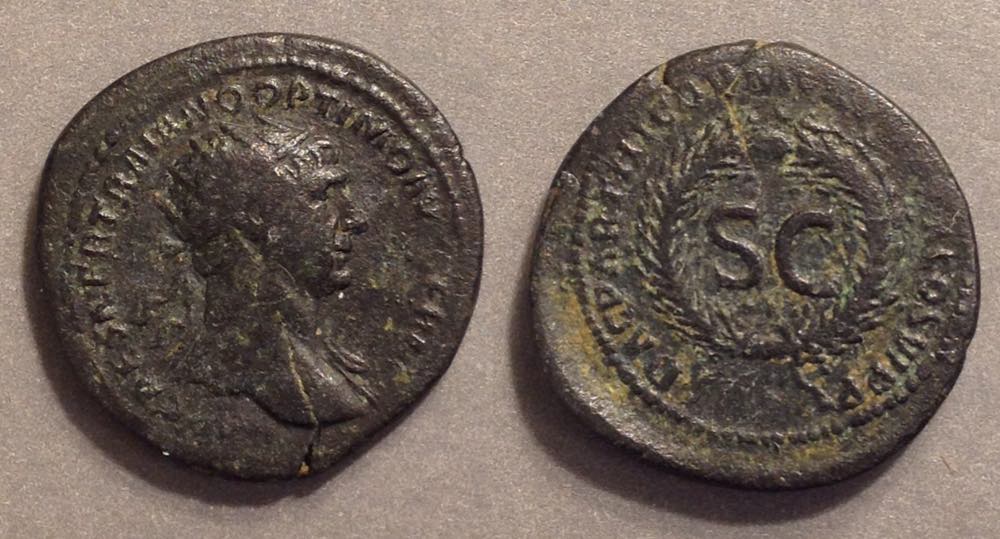
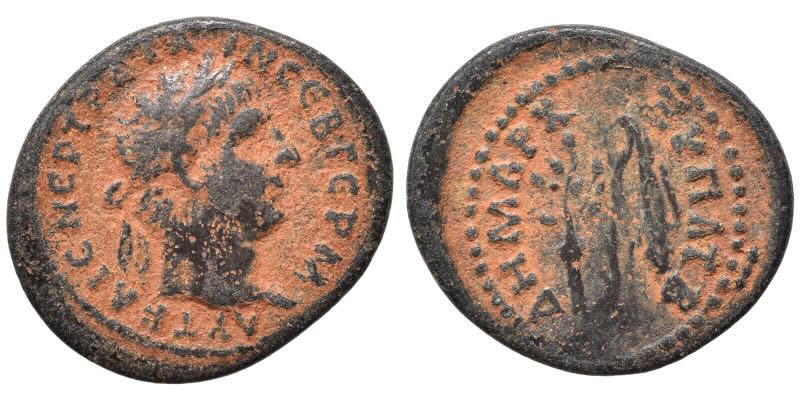 15.6-13.8 mm. 1.49 grams.
15.6-13.8 mm. 1.49 grams.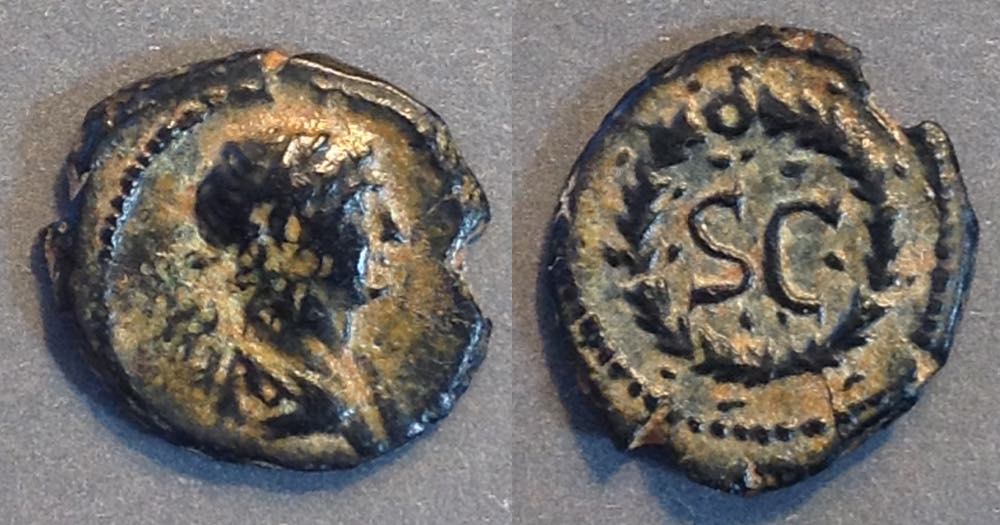 Trajan. 12 mm. 1.02 grams. Very small.
Trajan. 12 mm. 1.02 grams. Very small.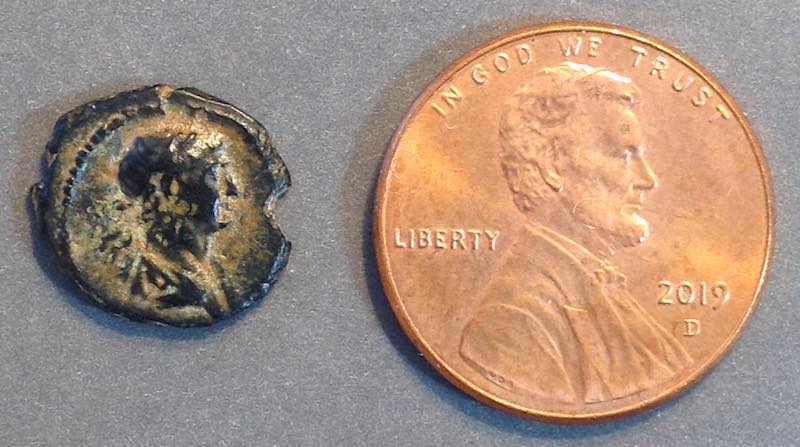
Hadrian (117-138)
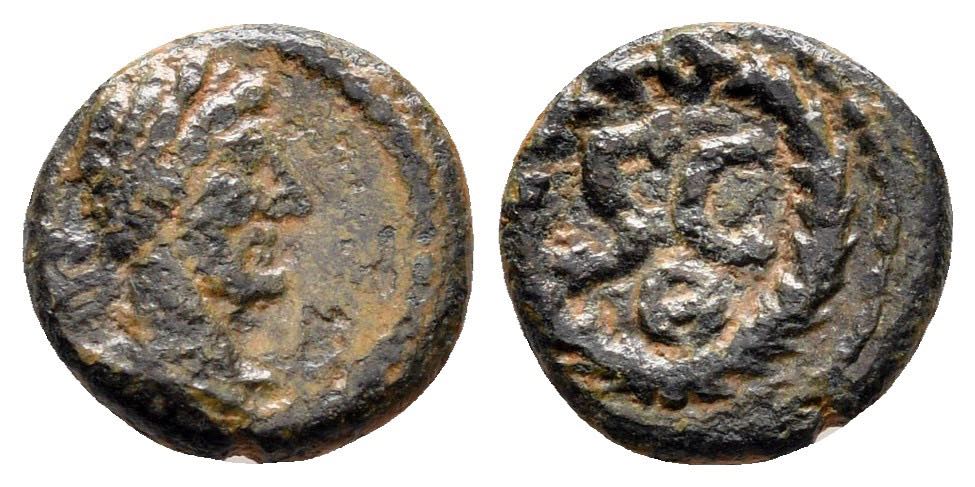
Hadrian, 117-138.
10 mm. 0.94 grams.
RPC III 3713 (very similar to 3704-3713, distinguished by the Θ)
Sear II 3705 "Rome 117-118"
RIC 629b
McAlee 543(i) p.222-3. "Half-quadrans, chalcous"
The portraits on examples for Hadrian are much cruder than those for Trajan.
 [Repeated from above]
[Repeated from above]Fortunately the legend
IMP CAESAR TRAIAN HADRIANVS AVG
names the emperor Hadrian (117-138)
and the reverse
PM TRP COS III
narrows the date range to 119-125
RIC 624. BMC 1278. Sear 3704.
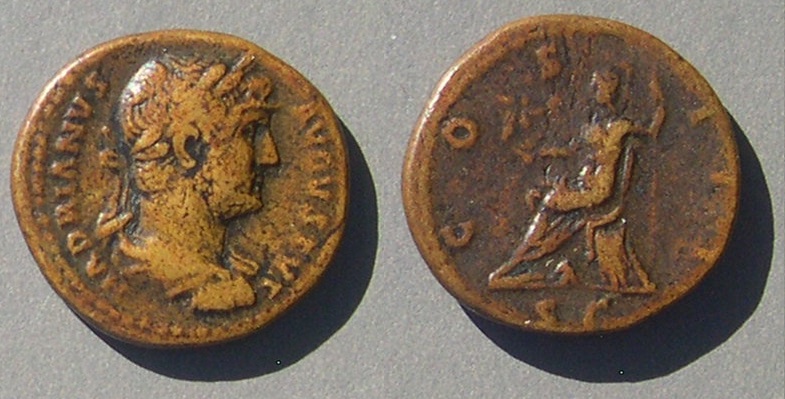 Hadrian
Hadrian 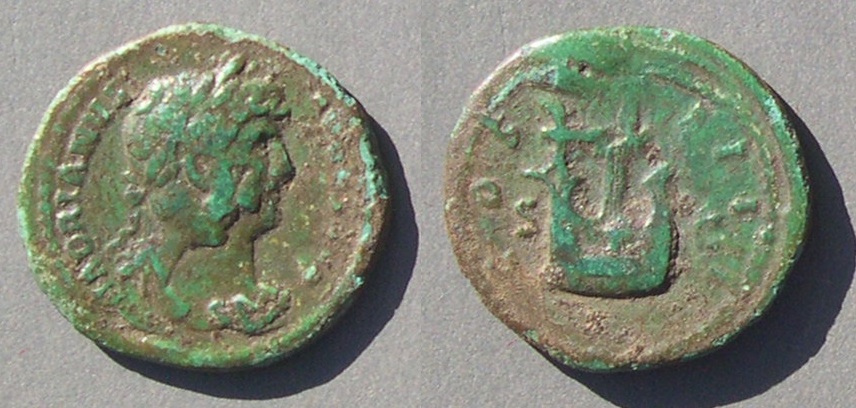 Hadrian (117-138)
Hadrian (117-138)
21-20 mm. Semis. 3.87 grams.
HADRIANVS AVGVSTVS
Bust right, laureate, draped, and cuirassed [double struck so the eye and nose appear twice, once with the neck at 7:30]
COS III
Lyre, S C either side
RIC 688, page 428, plate XV.312
BMC 1360, plate 83.9.
Sear II 3701.
This coin, at 21-20 mm, is larger than a quadrans.
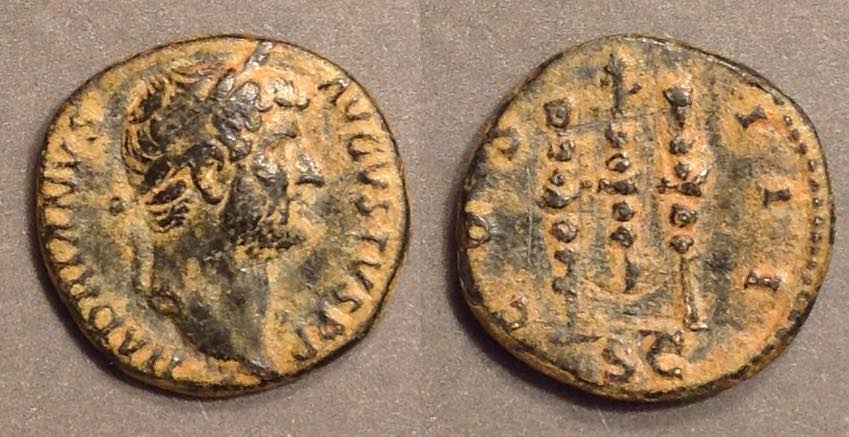 Hadrian (117-138)
Hadrian (117-138)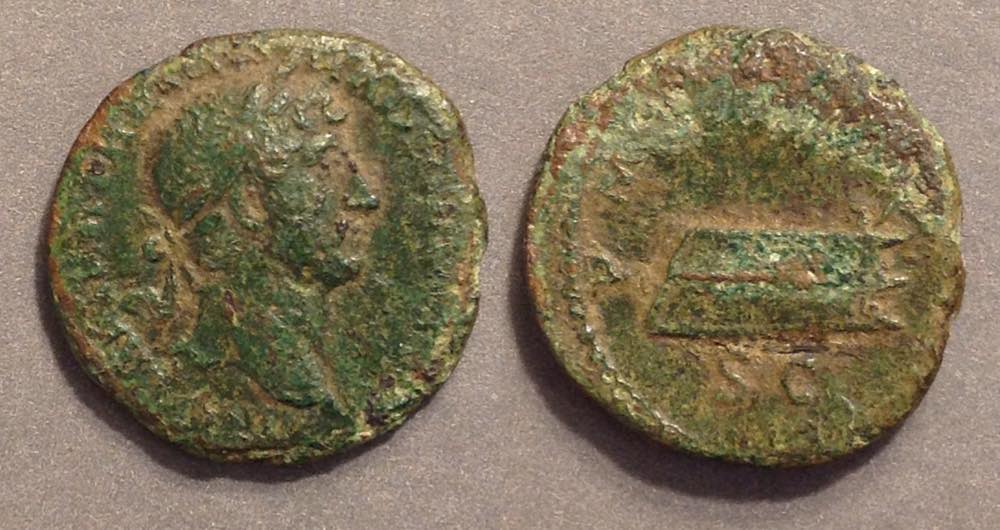
Hadrian (117-138)
17 mm. 2.97 grams.
(much corrosion obscures the legends)
IMP CAESAR TRAIAN HADRIANVS AVG
PM TRP COS III PP
rostrum tridens (prow with three-pronged ram) right
S C below.
RIC 623a "Scarce, 121-122"
I think this one is also a semis because it has an imperial portrait.
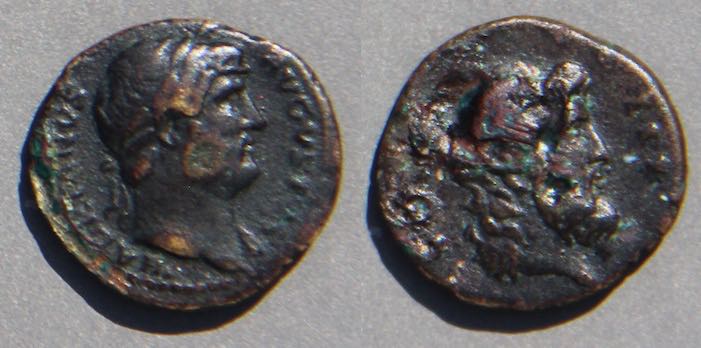 Hadrian (117-138)
Hadrian (117-138)
18-16 mm. Semis. 2.54 grams.
HADRIANVS AVGVSTVS
COS III around head of Zeus Ammon right
Sear II --. van Heesch 188-190 (pdf page 294).
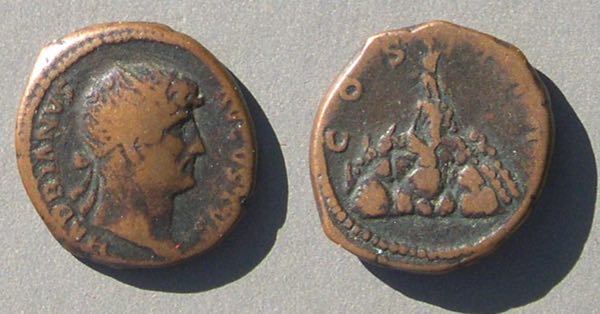 Hadrian (117-138)
Hadrian (117-138)
19 mm. Semis. 4.99 grams.
HADRIANVS AVGVSTVS
Head radiate right (the radiate makes certain this is a double denomination--two quadrantes make a semis)
The reverse has COS III and Mt. Argaeus, a design issued at Caesarea in Cappadocia.
BMC [p. 441 n] "the little pieces with COS III, Mount Argaeus, are certainly Eastern and therefore omitted here" (cf. 1356-7, plate 83.7, page 441).
These are Eastern, but of Roman style (possibly actually minted in Rome?) and surely of Roman denomination.
Roman Provincial Coins III 3159.
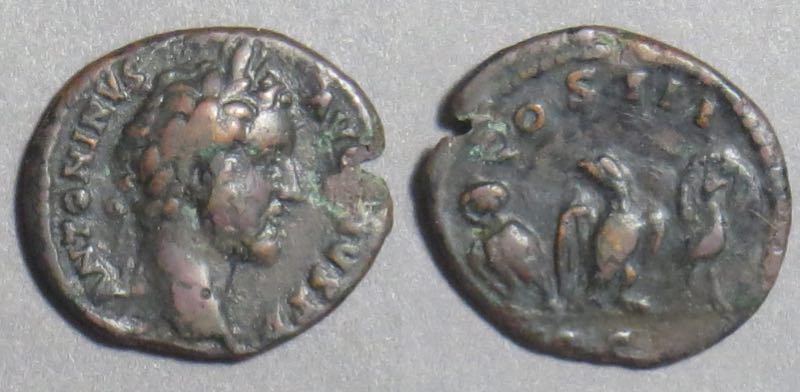 Antoninus Pius (138-161)
Antoninus Pius (138-161)
18-16 mm. Quadrans or semis. 2.55 grams.
ANTONINVS - AVG PIVS PP
Head right. laureate
COS III
Owl, eagle and peacock
for the Capitoline triad of Minerva, Jupiter, and Hera.
RIC III A.P. 709a, struck "140-144"
Sear II 4326
The next coin is a "orichalcum semis" struck locally for Antioch, Syria. It does not really belong to the series of quadrantes and semisses struck in Rome. It illustrates one semis-sized type among many from provincial cities, including small coins of semis-size issued long after the imperial mint discontinued the semis denomination.
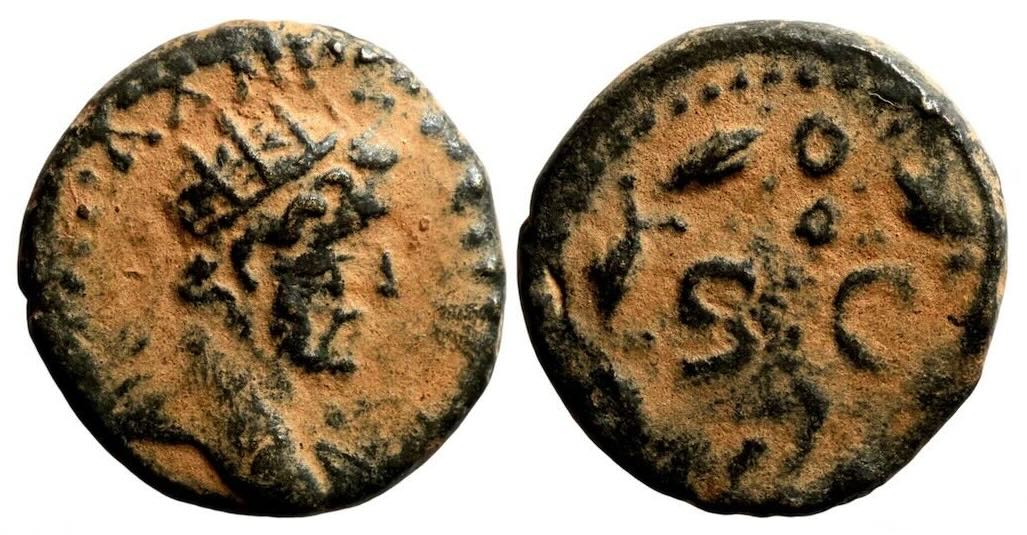 Antoninus Pius (138-161)
Antoninus Pius (138-161)
16 mm. 2.93 grams.
Radiate head right
SC in wreath. Θ above.
McAlee 565 page 235, variety (i).
Struck "c.145-147"
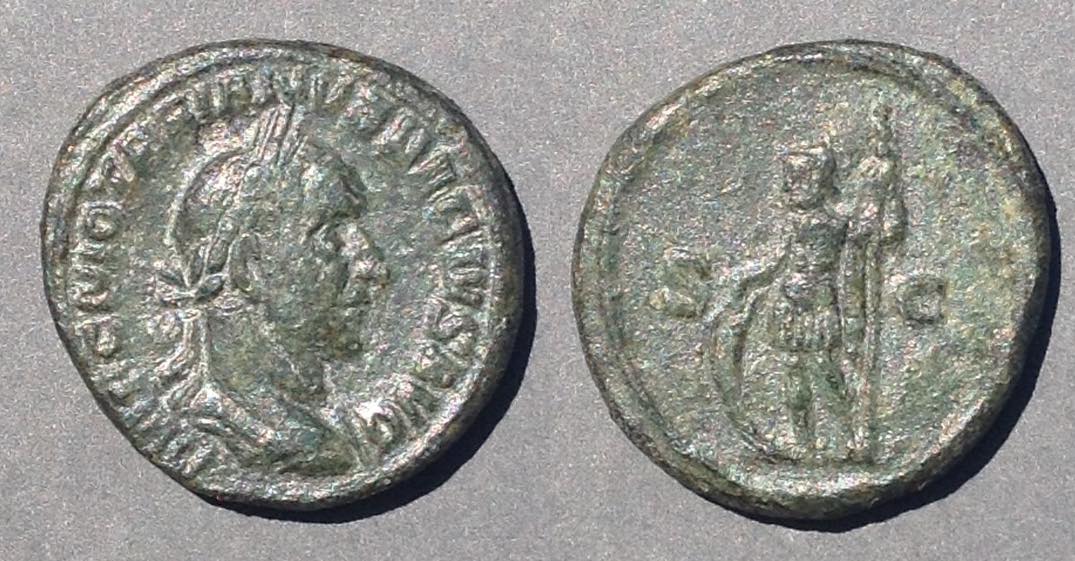
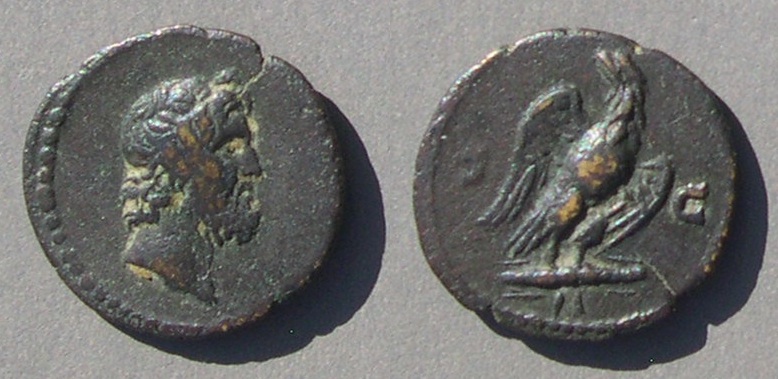 Anonymous.
Anonymous.
19 mm. 2.36 grams. This is large enough in diameter to be a semis.
Head of Jupiter, right
Eagle standing right on thunderbolt, head left, S C either side
Look at the bust. Does it remind you of any emperor?
Lamb suggests it was struck by Antoninus Pius.
RIC II 2, page 216
Sear I, 2916
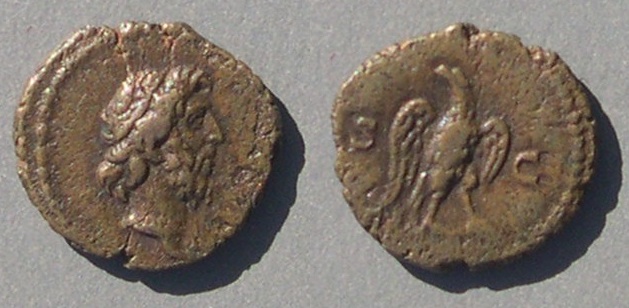
Anonymous. 15 mm. 1.86 grams.
Head of Jupiter, right
Eagle standing right on thunderbolt, head left, S C either side.
Look at the bust. Does it remind you of any emperor?
The obverse description is the same as the previous coin, but the bust is much different and the coin is smaller. This one has the chin line of Marcus Aurelius, not Antoninus Pius. A cataloger might describe the two with the same words, but a collector would be justified in considering them different types.
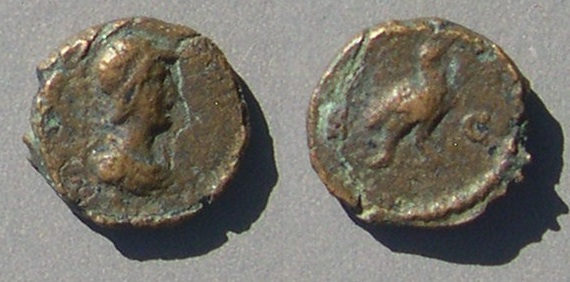 Anonymous.
Anonymous.
13 mm. 1.92 grams.
Minerva bust right, helmeted and draped
Owl half-right, facing, S C either side.
This coin is even smaller than the previous one. If the quadrans is the smallest denomination, this must be a quadrans. Maybe it is unusually small, but if not, then the two larger coins above are hard to explain, given the semis usually has a portrait of the emperor.
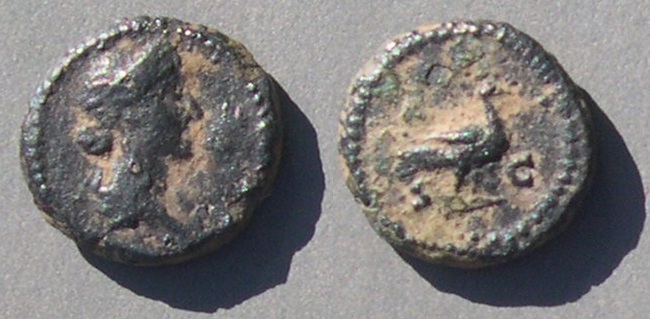 Anonymous.
Anonymous.Sear I 2924, page 520
Nothing on this coin suggests any particular emperor.
Lamb article type 46.
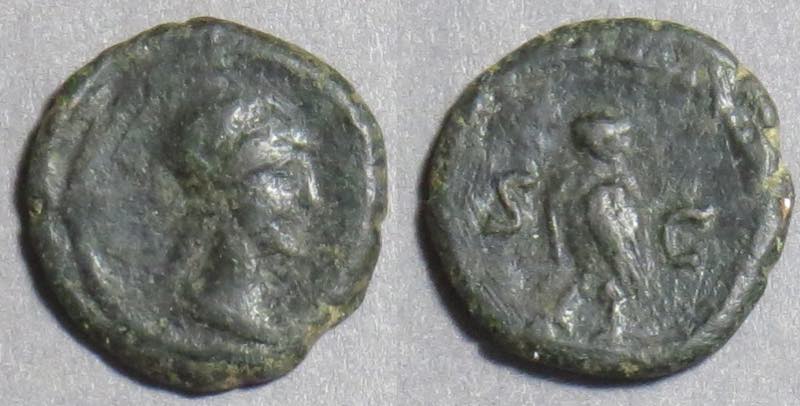 Anonymous.
Anonymous.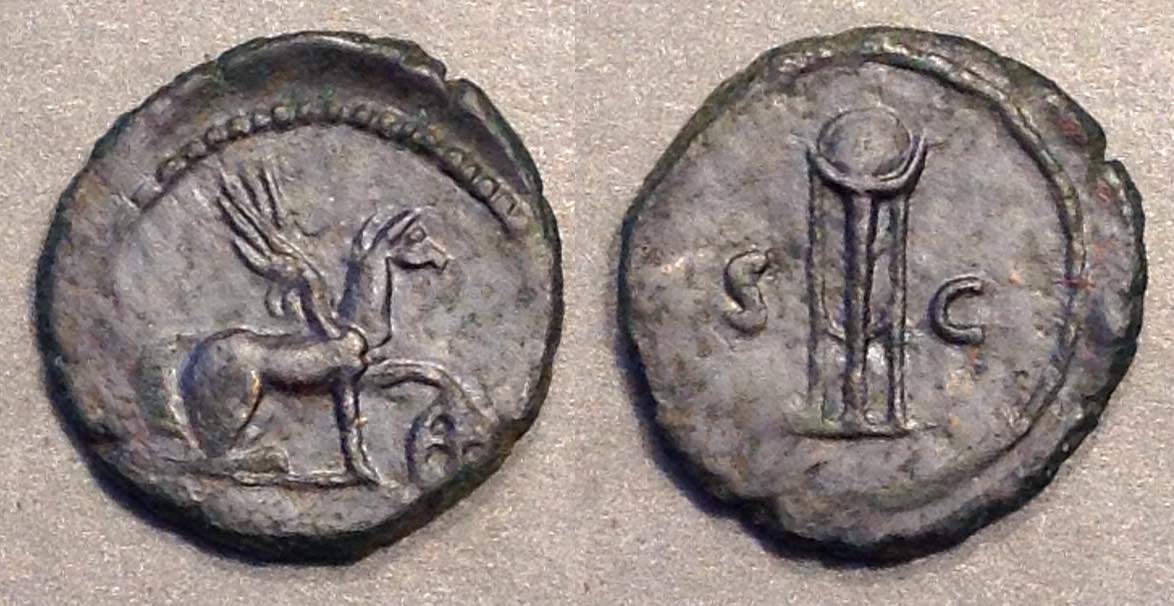 Anonymous.
Anonymous. [Repeated from above]
[Repeated from above]
An "anonymous" quadrans
15mm.
Attributed to the period from Hadrian to Antonius Pius (117-161).
winged petasus (cap of Mercury)
winged caduceus, S C on either side.
Nothing on the coin suggests a particular emperor.
However, there is, below, a quadrans of Nerva with the same reverse.
Perhaps that is enough to infer this coin is likely of Nerva (96-98).
 [Repeated from above]
[Repeated from above]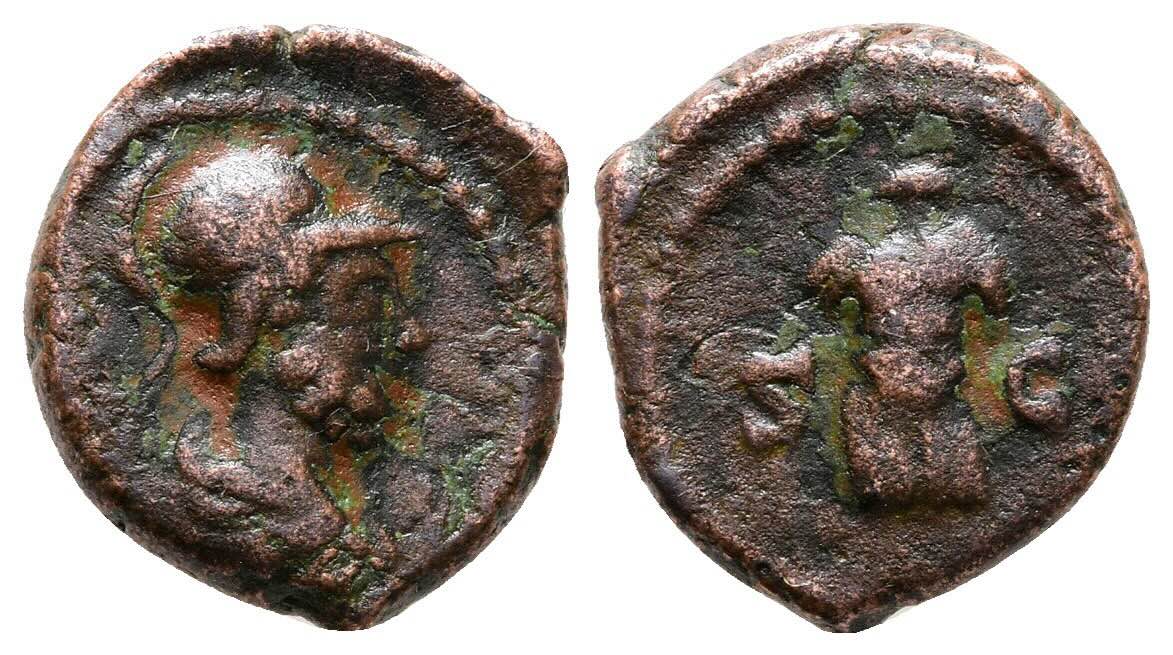 Here is another example with the same designs, but much smaller. (The images are proportional.)
Here is another example with the same designs, but much smaller. (The images are proportional.)
The first Roman coins were very large base-metal cast pieces issued in the early third century BC. The Roman as was originally a whopping coin weighing a Roman pound of twelve ounces and the quadrans weighed one quarter of that--three ounces. Under the financial strains of third-century wars their sizes decreased dramatically and by the middle of the second century BC the as and quadrans had become much smaller and seldom issued. The silver denarius dominated the official currency, almost to the exclusion of other denominations. The Roman state issued very little new small change, so the old copper coins served to fill the need and remained in circulation and became very worn. Also, small coppers were both imported from elsewhere and produced unofficially.
The Republican quadrans denomination was distinguished by three dots. The three dots on each side refer to 3 ounces among 12 in an as, making four of these to an as. The next two are quadrantes.
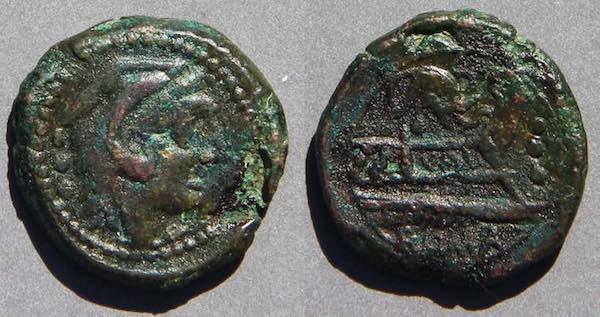 Anonymous Republican Quadrans.
Anonymous Republican Quadrans.
Anonymous, 128 BC, but likely to have been issued by a Caecilius Metellus (because of the elephant's head which that family used).
21-20 mm. 7.35 grams.
Head of Hercules right in lion-skin headdress, three dots vertically behind.
Prow right, elephant's head above, ROMA below, three dots vertically to the right.
Crawford 262/4. Sear 1163.
The quadrans of 128 BC is still much larger and heavier than it will eventually become.
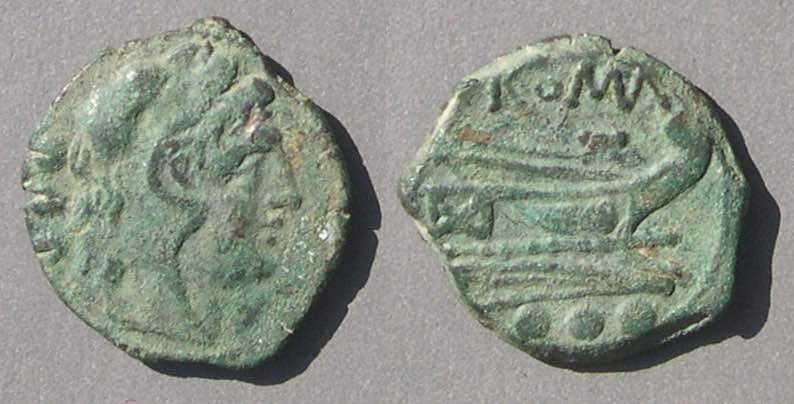 Anonymous Republican quadrans
Anonymous Republican quadrans
dated 91 BC
19 mm. 3.86 grams (half the weight of the previous quadrans)
Head of Hercules right in lion-skin headdress, three dots vertically behind.
Prow right, ROMA above, three dots below.
Crawford 339/4a. Sear 1195.
Republican quadrantes continue the Hercules/prow type. After c. 86 BC the denomination was discontinued and not revived until Augustus.
Here is a second example of the revived denomination (the first was near the top).
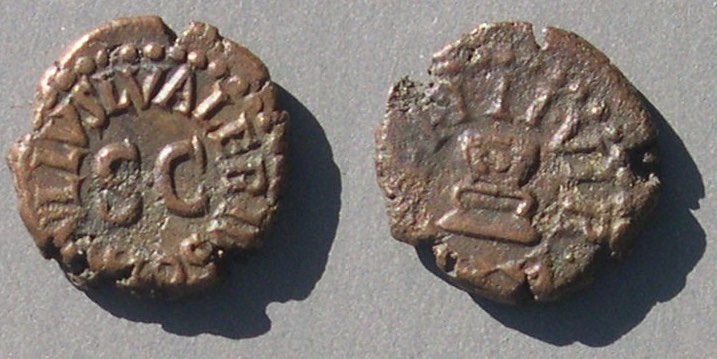 A quadrans struck under Augustus in 4 BC.
A quadrans struck under Augustus in 4 BC.
An Ancient Imitation. There cannot have been much profit in counterfeiting low-denomination coins, so this semis must have been produced to serve as small change where small change was in short supply.
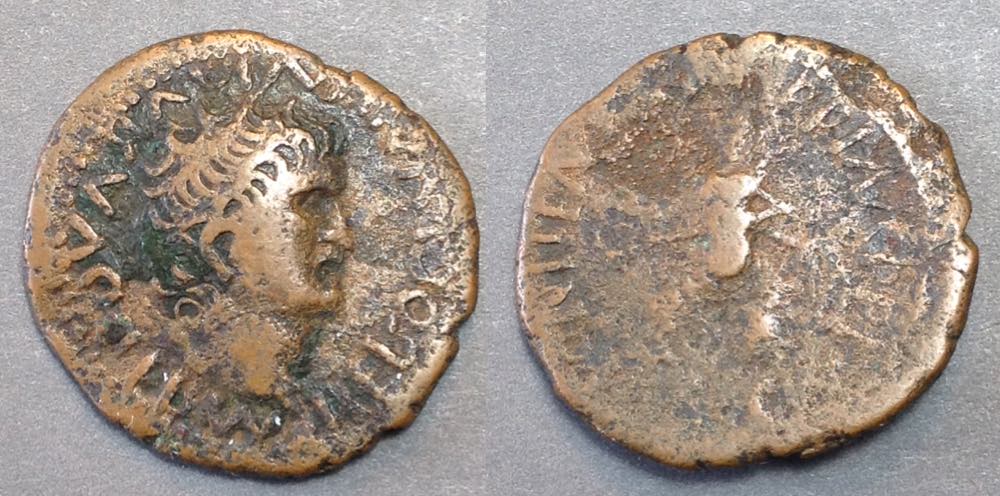 Nero, 54-68.
Nero, 54-68.
21-19 mm. 4.40 grams.
Imitation of a copper semis, possibly
BMC 260 (page 251)
Crude obverse legend but "NERO" attempted counterclockwise from 5:00.
Reverse legend clockwise from 7:00 beginning PONTIF(?).
Most semisses are orichalcum (brass), but some are copper. Both this coin and its prototype are copper.
Here is a good Numis Forums thread on these denominations.
Here is a page of reference works about the quadrans denomination. Here is a page on their fequencies.
Return to the top of this page.
Go to the main Table of Contents page for this whole educational site.